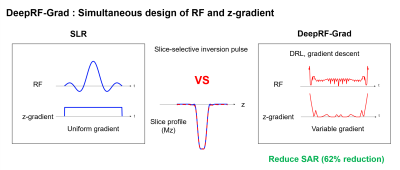Jiye Kim1, Dongmyung Shin1, Juhyung Park1, Hwihun Jeong1, and Jongho Lee1
1Department of Electrical and Computer Engineering, Seoul National University, Seoul, Korea, Republic of
1Department of Electrical and Computer Engineering, Seoul National University, Seoul, Korea, Republic of
We
developed a new deep reinforcement learning method that simultaneously designs an
RF pulse and a slice-selective gradient waveform for slice selective inversion
with reduced SAR and improved robustness to off-resonance frequency.

Figure 1. Summary
of DeepRF-Grad for a slice-selective inversion pulse. Compared to the SLR
results, the DeepRF-Grad designed RF pulse and z-gradient produced a
substantial reduction in SAR (62% reduction) while sustaining a similar slice
profile (SLR: blue line, DeepRF-Grad: red dashed line) and satisfying hardware
constraints (slew rate and maximum gradient). This idea of designing both RF
and gradient to reduce SAR is similar to VERSE and comparisons including
VERSE design continue in Figs 3 and 4.

Figure 2. Comparison
of a) DeepRF and b) DeepRF-Grad. Both methods use deep reinforcement
learning (DRL) and gradient descent. a) DeepRF designs only RF magnitude and
phase, while z-gradient is fixed as uniform. The loss function of DeepRF
consists of the slice profile and SAR terms. b) In DeepRF-Grad, z-gradient is
also designed simultaneously with an RF pulse. A slew rate term is added to the
loss function.